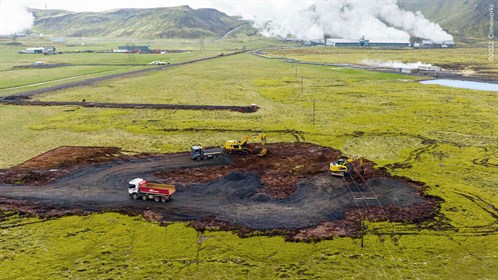Groundbreaking starts on Mammoth, Climeworks’ newest & largest CO2 direct air capture & storage facility
Climeworks announced that work has started on the construction of its newest and largest carbon dioxide direct air capture and storage plant - Mammoth.
The groundbreaking for this new plant represents a demonstrable step in the company’s ambitious CO2 capture and storage scale-up plan: multi-megaton capacity by 2030, and on track to deliver gigaton capacity by 2050.
In September 2021, Climeworks began operations at Orca, its first-of-a-kind plant, kick-starting the supply availability of high-quality carbon removal.
Following a recent equity raise of USD 650m, Climeworks is focused on rapidly scaling-up capacity on the market. It will concentrate on implementing large modular direct air capture and storage facilities, investing in technological development, and growing its organization globally.
Mammoth is Climeworks’ 18th project and its second commercial direct air capture and storage plant. It is designed with a nominal CO2 capture capacity of 36,000 tons per year when fully operational – an order of magnitude larger than Orca. Located in Iceland, construction is expected to last 18-24 months before operations start.
Carbfix, Climeworks’ CO2 storage partner, will provide the permanent underground storage of carbon dioxide.

The Hellisheiði electricity power plant operated by ON Power will supply Climework’s Mammoth plant and the Carbfix CO2 injection sites with renewable energy to run the entire direct air capture and storage process.
Mammoth is designed to further expand supply and provide engineering experience for Climeworks 10x scale-up steps. It capitalizes on a very dynamic market demand – with several 10-year offtake agreements signed over the last months – and technology learnings from operating Orca.
“Today is a very important day for Climeworks and for the industry as construction begins on our newest, large-scale direct air capture and storage plant,” said Jan Wurzbacher, Co-Founder and Co-CEO of Climeworks.
“With Mammoth, we can leverage our ability to quickly multiply our modular technology and significantly scale our operations. We are building the foundation for a climate-relevant gigaton-scale capacity, and we are starting deployment now to remain on track for this.”
“Based on most successful scale-up curves, reaching gigaton by 2050 means delivering at multi-megaton scale by 2030. Nobody has ever built what we are building in DAC, and we are both humble and realistic that the most certain way to be successful is to run the technology in the real world as fast as possible. Our fast deployment cycles will enable us to have the most robust operations at multi-megaton scale,” said Christoph Gebald, Co-Founder and Co-CEO of Climeworks.

- ADNOC Gas awards $2.1 B in contracts to enhance LNG supply infrastructure
- U.S. Department of the Treasury releases final rules for clean hydrogen production tax credit
- Tecnimont to build waste-to-biogas plant to fuel local kitchens in India
- Indonesia regulator confirms disruption at bp's Tangguh LNG project
- Topsoe, Aramco sign JDA to advance low-carbon hydrogen solutions using eREACT™



Comments